Herbarium: types, features of collecting plants and design options
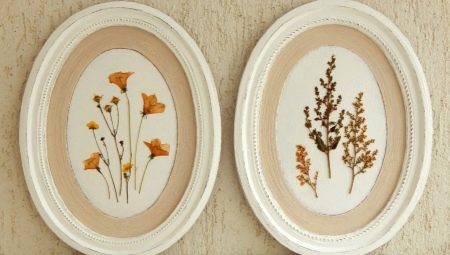
A herbarium is a traditional decoration that has existed for many years. Compositions of dried plants, previously popular only among botanists, are now able to decorate almost every house or apartment. They are used to make pictures, bouquets, albums, and even postcards. To create such beauty, it is necessary not only to have a sense of taste and imagination, but also perseverance.
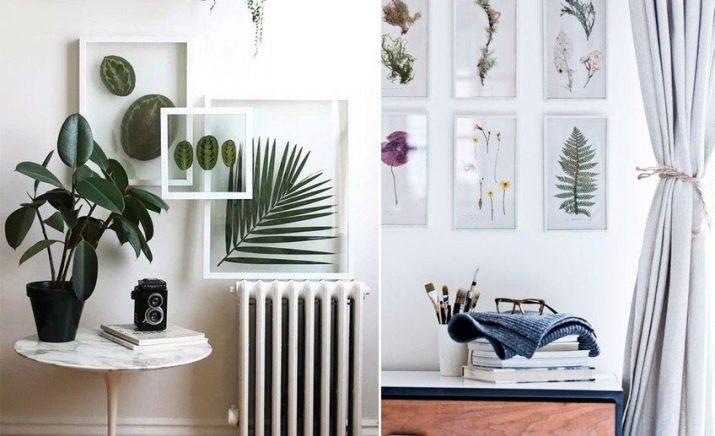
What it is?
Translated from Latin, herbarium means "grass". It is a collection of conventionally dried plants. Depending on their type, it can be either a single flower or branch, or a whole plant. Initially, herbaria appeared in Italy at the beginning of the 15th century. The founder of this art form was the famous botanist of the Pisa Botanical Garden, Luque Guini.
To date, not a single copy created by his hands has survived, but some of the collections of his students still remain.
Almost all exclusive herbariums are registered in international databases. In addition, each plant is assigned a special letter code, which consists of six letters of the English alphabet. However, today plants are dried for more than just science. Most people turn collecting plants, flowers and creating compositions from them into a hobby.

What is necessary?
You can store the herbarium in a special album with files, which will contain not only dried plants, but also inscriptions about their origin. Albums can be purchased at specialty stores or made by hand.To do this, you need to take either very thick sheets of paper or cardboard and place them in files. You should not fasten them together. Better to get a regular binder folder. In addition, you can use dried plants as bookmarks in a book or create paintings or panels from them.
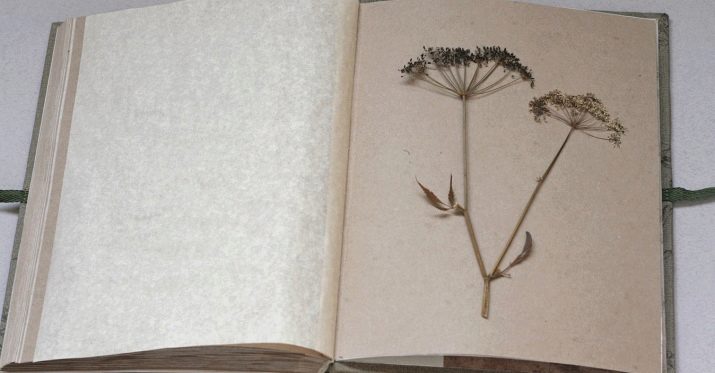
And also some masters use herbariums to decorate caskets or plates, or make cards from flowers.
Classification
You can make a classification of herbariums into several subgroups.
- Special. Such a herbarium is intended for a specific purpose. For example, a teacher in a school might ask to create a thematic collection of plants based on the material covered.
- Periodic. Most often, this distribution is done by the seasons. For example, in the spring you can dry the shoots of bird cherry or cherry blossom, in the summer - flowering medicinal or ordinary plants, in the fall - colorful leaves or bunches of mountain ash, and in winter - unusual branches from the trees.
- Systematic. Most often, such herbariums are compiled on the basis of already collected plants. But they are arranged alphabetically or by type. That is, everything is gradually being systematized.
- Thematic... Such a herbarium consists of certain specimens of the species. Separately, there are medicinal plants, such as chamomile, mint, sage or wormwood. And also weeds or cereals can be selected for collection.
- Floristic. Such a herbarium is collected in a specific place of residence.
- Morphological... In this case, the individual plant is collected in parts. In addition, you can harvest the same plant at different periods of its growth.
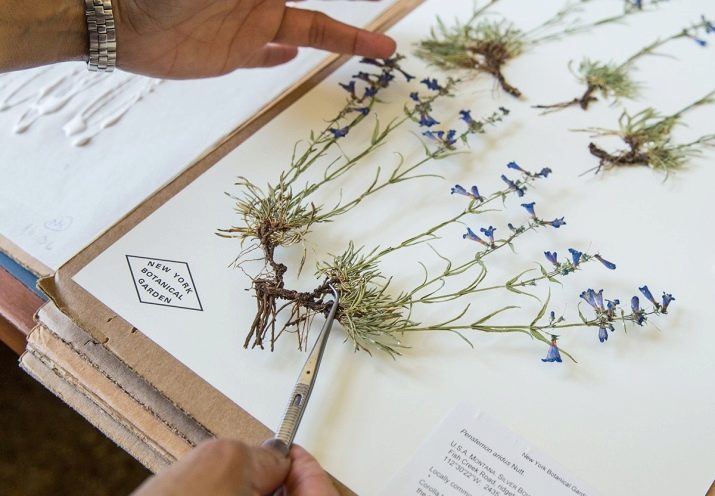
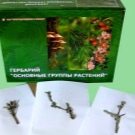
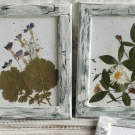
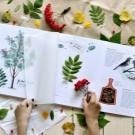
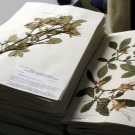
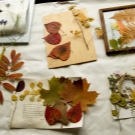
How to collect and dry plants?
To make a herbarium, you can collect completely different plants. It can be leaves from trees, and flowers, different in size, and cones, and even moss or tree bark. This variety is suitable for those people who create voluminous compositions. However, before starting to collect plants, it is imperative that you familiarize yourself with the following rules:
- you should not go for plants early in the morning, when the dew has not yet dried or in rainy weather, you need to collect the herbarium only in sunny weather; if it has been raining recently, you need to wait at least 2-3 hours;
- before collection, it is necessary to inspect the entire plant well and make sure that there are no damage or insects on it that can damage it;
- if there is no need to pull out the plant along with the roots, then you need to carefully cut it off with a sharp knife or scissors; if everything is needed, then the roots must be well separated from the ground, and also washed;
- you do not need to collect more plants than you need;
- it is necessary to bypass those copies that are listed in the Red Book;
- it is better if the collected samples are of different sizes, which will make it possible to make more beautiful compositions; in addition, you need to remember that the plants should be collected during the period of their full disclosure.

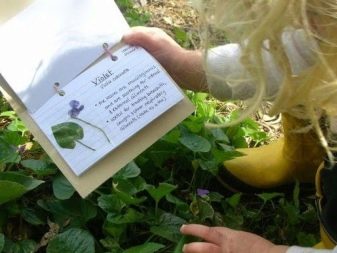
In addition, deciding to collect a herbarium, you must definitely take with you such items as:
- small scoop for digging;
- knife or scissors;
- special paper for drying or a simple newspaper;
- a pencil or pen, as well as a notebook so that you can write not only what kind of plant it is, but also the date and place of its collection.




You can dry any plant in different ways, each of which has its pros and cons. Whichever drying option is chosen, first you need to give the plant the desired shape.
Drying naturally
In this case, you do not need to use any accessories. The plants found will be able to dry out on their own in the place where they were placed. In addition, they can be made both voluminous and flat. Using this option, you need to be prepared for the fact that the herbarium can quickly collapse or lose its natural color.In addition, such samples are not very suitable for various crafts, since they simply cannot withstand the effects of glue and other similar materials.
It takes 1 to 3 weeks to dry the herbarium without using special devices. It all depends on the volume of the plant itself.
In addition, after the end of this process, you need to remove the plants only with tweezers so as not to damage them, because after drying they become very fragile and brittle.
Drying press
This option is considered basic, because it is more reliable, and the plant will look beautiful at the end. In addition, it can remain in this state for many years. You can use two options.
- Unnecessary books. This option is more suitable for amateurs and has been used for a long time. First you need to level the plant well, and then place it on the page of an unnecessary book. From above it is necessary to cover with a sheet of paper, which experts call a "shirt", and also put a piece of paper with the necessary information here. Next, the book must be carefully closed and placed under several books. It is very important that the specimen does not accidentally move while doing this.
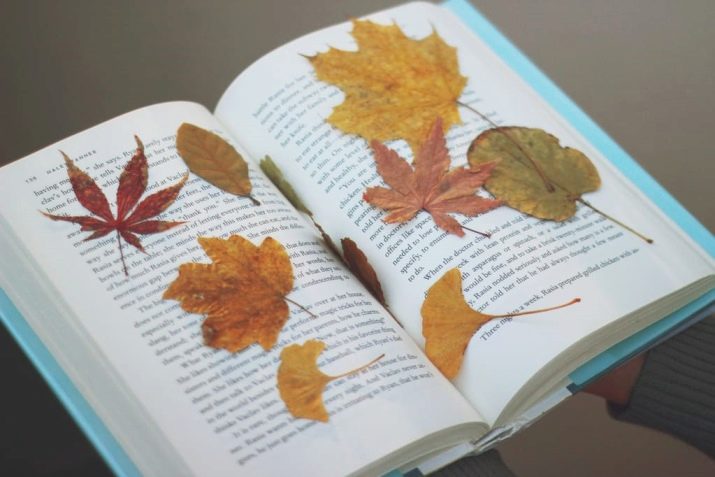
- Herbarium press. Such a device is intended for drying various plants. It consists of two boards of the same size. There are holes along the edges, through which the ropes are threaded. With their help, these boards are fastened. The prepared samples should be put in the "shirts" and then put between the boards. After that, clamp the device well. It can dry up to 45–50 collected samples at a time. To speed up the process, you can take the device outside during the day and bring it back in in the evening.

Important! Whichever option was not used, the "shirt" must be changed daily, because it absorbs all the moisture from the plant. If not changed in time, it will lose its natural color.
Bulk drying
Most often, this method of drying is used to preserve plants in their original form. They can be used to make not only paintings, but also bouquets. First you need to take a container in which the plants will be dried. Then carefully arrange the samples in the prepared dish, top down. Next, you need to cover them with a special drying agent called silica gel.
The entire plant must be completely covered. After 15 days, you can take out the dried plant and use it for its intended purpose. It is not recommended to use silica gel a second time, because it has already absorbed all the moisture from the dried samples.
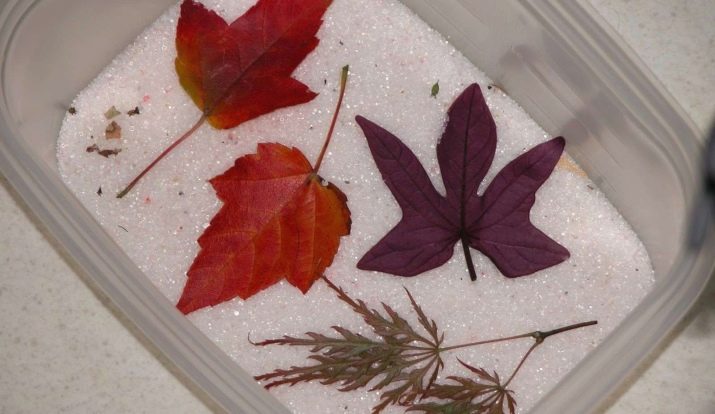
Alternatively, try drying herbarium specimens with glycerin. To do this, you need to mix glycerin with clean water in a 1: 3 ratio.Then it must be poured into a container prepared in advance. A small incision (up to 5 centimeters) should be made on the stem of the plant and placed carefully in a solution of glycerin. It is necessary to process every millimeter of the sample with this solution, so it is better to do this.

After 2–4 days, you can remove the sample and put it in a dark place to dry.
Fast drying
With the help of some household appliances, plants can be quickly dried. However, this does not mean that the quality of the samples will be good. Such drying should be used only in the most urgent cases.
- With an iron. When using such an appliance, be sure to make sure that there is no water in the steam compartment. Then it should be heated to medium power and only then can the drying process begin. You need to apply the iron to the plant for a few seconds, and then remove and allow the same time to cool. Repeat everything until the plant is completely dry.
- In the microwave. Placing flowers or leaves, turning on the appliance at full power, you can literally dry the plants in 2-3 minutes.
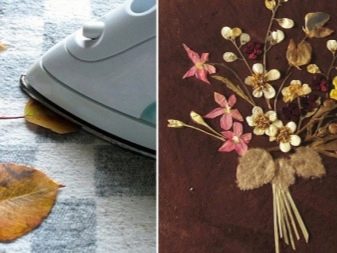
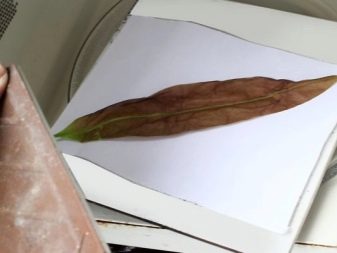
Important! Using any of the selected methods, it is necessary to first place the sample in a “shirt” before starting drying.
How to make a herbarium?
When all the drying stages are over, you can try to make various crafts with your own hands. There are many ideas for such compositions, since human fantasy knows no boundaries. However, the choice always remains with the person who does it.
In the album
If this is the chosen method, all samples must be placed according to certain types. Leaves, flowers, medicinal herbs, tree branches should go separately. In addition, if you plan to use such an album for needlework in the future, it is better to place all the samples by color, so that it is easier to work with them. You can make such an album yourself, or you can just go to a craft store and buy it. In any case, samples should be placed on each sheet separately. In addition, there must be inserts made of tracing paper between the sheets.
Plants can be attached in different ways. For example, if in the future it is planned to use them to decorate some crafts, then you need to glue it lightly. For this, double-sided tape is suitable, which will easily peel off from the sample.
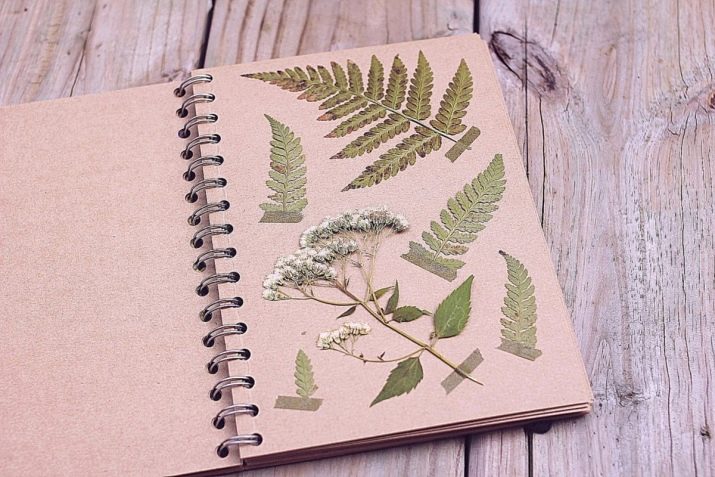
If the album is made only for viewing, then you can glue it "tightly".
Panel
This use of the herbarium is considered the simplest and easiest. Not only an adult, but also a child can cope with it. Or you can make such a creation together. To create it, you must prepare the following materials in advance:
- thick sheet of paper or cardboard;
- dried plants;
- frame - samples can be stored both in glass and without it;
- glue;
- sharp scissors.
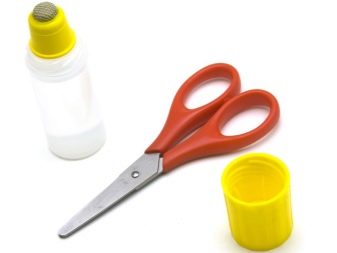

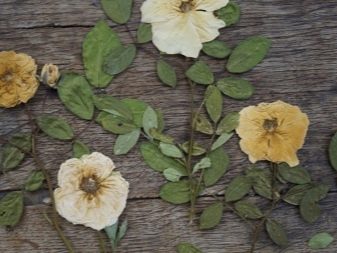
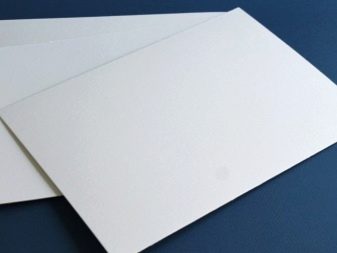
Further, on a blank sheet of paper you need to apply a drawing of the future picture, and then glue all the necessary elements. After that, the sheet should be placed in a frame, more correctly if it is with glass. So the samples will retain their appearance longer, in addition, the composition itself will also look more beautiful. In this way, you can create not only panels, but also Provence-style paintings or various applications for your children.
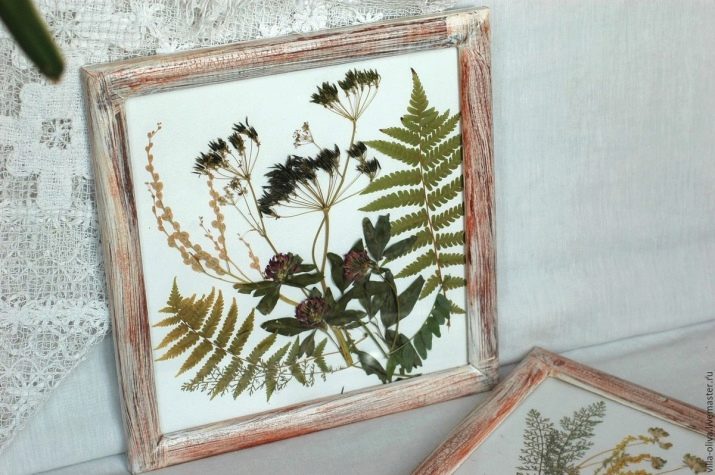
Herbarium wreath
A wreath on the door always looks very beautiful. In addition, he immediately attracts glances to himself, as if inviting to come to visit. It will not be difficult to make it, you just need to take the following materials:
- a small piece of dense wire;
- nippers;
- sharp scissors;
- cling film;
- plant samples;
- threads to match the plants.

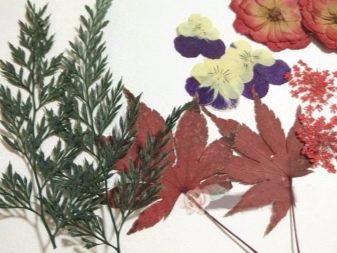
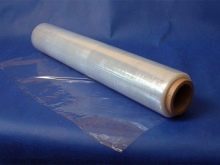
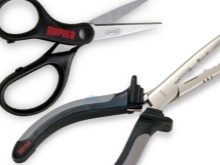
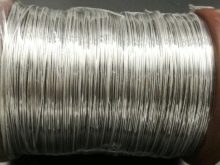
First you need to make a frame from the wire with a loop for hanging. In the meantime, all plants need to be distributed in bunches and secured with cling film, cut into pieces of 5 centimeters, to the frame of the wreath. If the bunches with samples are more voluminous, the larger the wreath will turn out. When the last bunch of plant samples is fixed, you can also decorate the wreath with ribbons or beads.

Storage rules
If you follow the following storage rules, then the herbarium can be stored for many years and also go to the next generation:
- all dried plants must be stored in a dry and sufficiently ventilated area;
- each of the samples must be correctly drawn up;
- for long-term storage, each of the samples must be treated with special insecticides in order to protect against the attack of various parasites;
- the storage area must be well protected from sunlight.
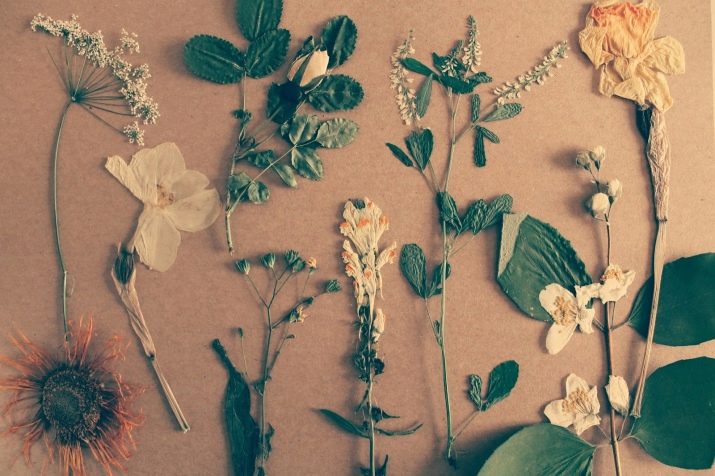
Examples in the interior
Now many complement the design of individual rooms with compositions from dried plants.
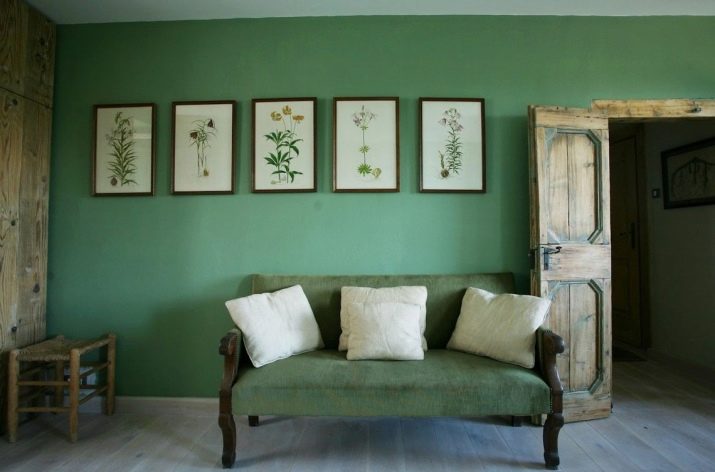
On the wall
A beautifully decorated painting from a herbarium can not only complement the interior of a room, but also completely transform it. Samples of plants taken from botanical gardens will look especially beautiful.
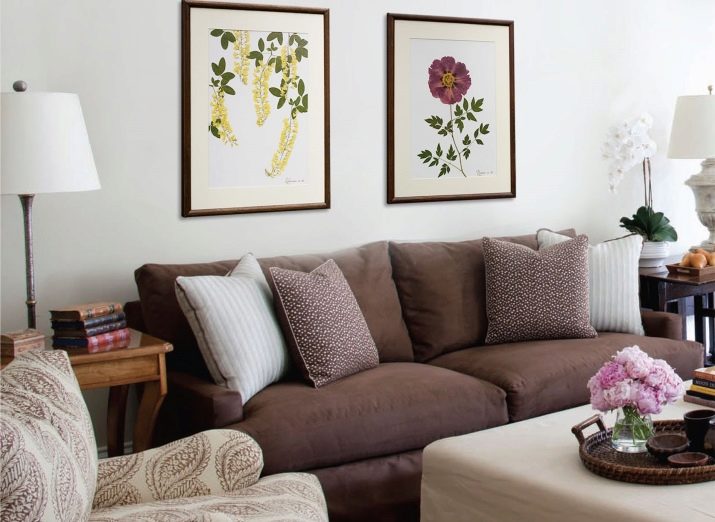
Living room in Provence style
Decorating a room in this style, you can decorate with paintings and compositions not only the walls, but also all other corners of the room. For example, arrange vases with dried flowers using volumetric drying. In addition, you can hang not one, but several dried bouquets from the ceiling at once.This will not only add unusualness to the room, but also fill the entire room with the scent of herbs.
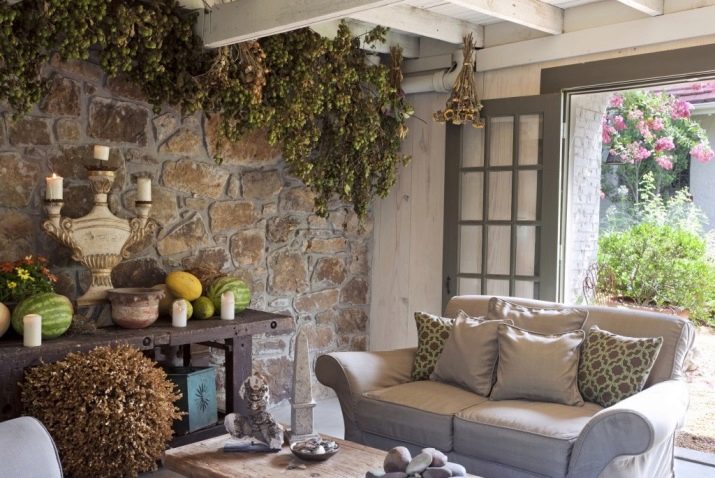
It is worth noting that anyone can practice herbarium. It's not difficult at all. The main thing is to have the desire and be able to fantasize a little. Only in this case it is possible to obtain as a result not only a simple album with dried plants, but also a beautiful addition to the interior of the room.
For information on how to properly prepare dried flowers and dry the herbarium, see the video below.








